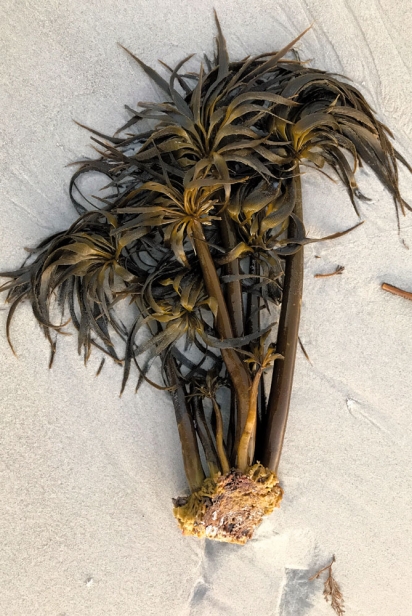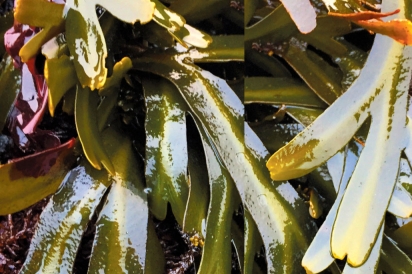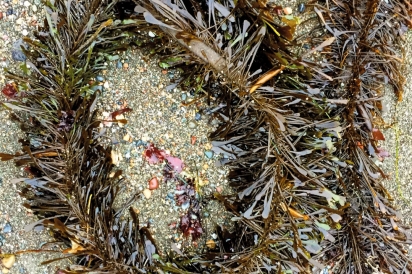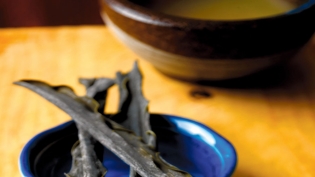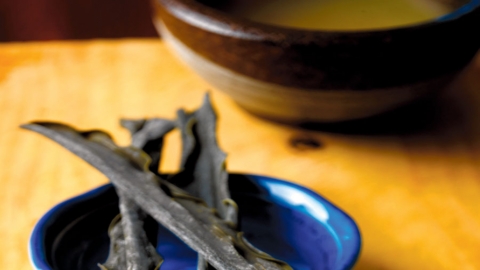Harvesting Umami
RARE NEGATIVE LOW TIDE FOLLOWING A FULL MOON SERVES UP A PICK-YOUR-OWN SEAWEED FARM
Seaweed harvesting is something I’d never seriously contemplated, akin to collecting quenelle spoons or harvesting gulls’ eggs: niche and unnecessary. But, for me, integral to excitedly looking forward to each season is understanding what gifts bestowed by Nature reach their peak moment during that time, and finding the secret spots and rich patches where they can be harvested.
Seaweed has a season? In truth, my experience of seaweed had been limited to fish wrapped in nori sheets, and the often muculent salads of wakame, hijiki and red dulse in middling Japanese restaurants, or occasionally in the homes of hippie friends who slip it into their cooking without much mention.
And yet, seaweed’s briny jolt never fails to reset my palate with an explosion of umami, one of the five basic tastes. Not to mention that seaweeds, a very, very broad category of marine plants and algae that includes kelp, are more nutritious than land-based plants and high in protein, one of the richest sources of minerals we ingest vegetally, with varying amounts of magnesium, calcium, sodium, potassium, iodine, iron, zinc, vitamin A, B1, B2, B6, niacin, vitamin C, pantothenic acid and folic acid. There are also trace amounts of vitamin B12 in seaweed, which seldom occurs in land plants, and many varieties contain anti-microbial agents that help fight disease.
So rich in vitamins and minerals essential for brain development are seaweeds that they are thought to have played a key role in human-kind’s evolution. In an article entitled “The Kelp Highway Hypothesis: Marine Ecology, the Coastal Migration Theory, and the Peopling of the Americas” in the Journal of Island and Coastal Archaeology, a group of archaeologists and marine ecologists posit that kelp forests may have played a role in facilitating the movement of maritime peoples from Asia to the Americas near the end of the Pleistocene era, some 14,000 years ago. Then, as now, extensive and highly productive kelp forest ecosystems of the Pacific Rim support other marine life and resources relied upon by coastal peoples.
The miso icing on this briny cake? Seaweed is low-cal and virtually fat-free.
So off I go…
First daylight filters wearily through a chilly Sonoma Coast fog, its thick silence an amplifier for the bark of a seal or the exhale of a migrating whale. Wrapped in heavy layers of flannel and an old pair of boots, I treat myself to a mug of steaming jasmine green tea and a cigarette of smoldering green bud, hands down my favorite breakfast. But it would be a light meal, as I would require my wits for the day ahead; seaweed harvesting is not for the faint of focus or weak-kneed.
Peering over the cliff to the rocky beach below calls to mind a tenet of permaculture: Life is amplified on the edge, where there is a confluence of valuable and diverse microcosms, where plants and animals work together within a sustainable system rather than as single elements. There is no more of an edge than where land meets sea, a place where seaweed is a source of life for many different species of marine animals.
And with this morning’s rare, negative low tide following a full moon, the Pacific is a veritable pick-your-own seaweed farm of slimy red, green and brown jewels.
Yes, seaweed is also farmed, widely, and has been for centuries in many cultures. Today the global seaweed haul is worth more than $6 billion, exceeding the value of global lemon and lime crops. But our aims are far more modest, focused on recreational harvest for our table, which in California means a daily bag limit of 10 pounds wet weight taken from the Pacific anywhere except designated Marine Protected Areas.
At times on all fours, petrified of a tumble, I navigate the gargantuan cliff we have to cross to reach the beach. Heart rate returning to normal, we join the lithe and agile Heidi Herrmann, proprietor of Healdsburg’s Strong Arm Farm. Heidi forages for sea vegetables in season, as well as growing medicinal herbs, flowers and vegetables on her CCOF-certified organic farm. She also leads foraging expeditions, anointing the unenlightened with sea tangles and saltwater, and today we are in her expert care.
We wade out calf-deep into the rocky outcroppings, salt spray from the surf licking lips and fluttering eyelashes. The moon waning, I tiptoe through the tide pools, not wanting to disturb the vibrant pink starfish, their fat arms left mercilessly exposed by the low tide. Once again on all fours, I struggle across the rocks, made slick and slimy from the various seaweeds and grasses. Focusing my harvesting knife on the sides of rocks, away from possible sneaker waves, I methodically fill my basket as the sun peeks out from behind the curtain of fog, a wizard changing the colors of the frothy waters from gray-blue to green, turquoise and aquamarine, like the veined stone in a ring from Arizona.
As instructed, we cut the fronds halfway down and well above the rock “holdfast” to which they cling, only harvesting those seaweeds that grow in abundance. Unlike wild mushrooms, there are no toxic North American seaweeds found in the Pacific, so foraging here is not a game of potentially lethal roulette, but some are more delectable than others. Seaweed should only be harvested in clean ocean waters, however—freshwater seaweed is often poisonous, and when ocean waters are contaminated, the seaweed turns neon-colored and should be completely avoided.
We harvest from the intertidal zone, the area above water at low tide and underwater at high tide. Even more interestingly, we also forage the subtidal zone, the area usually submerged and only exposed during extreme low tides following a full moon. The subtidal zone is home to a great diversity of plants and animals, such as kombu (Laminaria), a silky perennial seaweed with an umami taste that thickens soups and helps make beans more digestible. It’s also credited with reducing blood cholesterol and hypertension. On the same rocks, we also harveste wakame (Undaria pinnatifida), an annual kelp loaded with calcium and used in seaweed salads.
Grapestone or Turkish washcloth (Mastocarpus papillatus) is a perennial red alga found on rocks in the mid-to-high intertidal area. When dried, its rough surface may be used to exfoliate skin. The unfortunately named bladder chain kelp (Stephanocystis osmundacea) is a perennial brown alga found on rocks in low intertidal to subtidal areas. The bladders are pneumatocysts, which provide buoyancy to the seaweed so it’s able to float close to surface sunlight. The bladders pop in the mouth like a salty kid’s candy and make a dynamite pickle.
The prolific sea lettuce (Ulva species), the taste of which aptly reflects its bland name, is an annual green alga residing on rocks, mollusks, wood and other algae throughout intertidal and subtidal areas. It can be eaten fresh with rice wine vinegar or dried with sesame seeds.
Finally, we harveste several pounds of nori (Porphyra), the kale of the ocean, and one of the world’s more valuable aquaculture crops. An annual red alga, Nori can be found on rocks and human-made structures throughout the intertidal and upper subtidal area. One of the most delicious seaweeds, it can be toasted and added to foods like a salty spice.
On Heidi’s recommendation, we also pluck several feather boas (Egregia menziesii) from the beach, adding them to our haul to be wrapped around the base of our citrus trees, adding valuable minerals to the soils as they decompose, a Liberace adornment for kaffir lime and Meyer lemon.
Back at home, we rinse the seaweeds repeatedly, liberating a shocking quantity of sand, grit, crabs and large sea bugs, then drape them around the back patio to dry. Roughly 90% water, seaweed dries quickly; within the space of a day in the hot sun, the dried seaweed is ready for storage in airtight glass jars, flavor-filled reminders of our morning in the Pacific, and the bounty of Nature.




